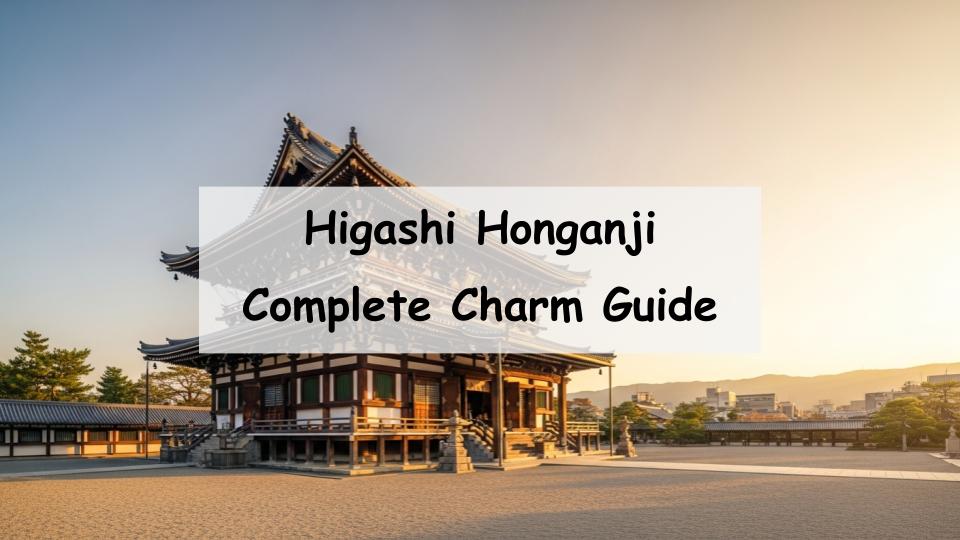If you’re visiting Kyoto and looking for a place where history and tranquility meet, Higashi Honganji is the perfect destination.
Many visitors often ask, “What makes Higashi Honganji special?” “How is it different from Nishi Honganji?” or “What’s the best way to get there?”
The answer is simple: Higashi Honganji combines awe-inspiring architecture, a peaceful atmosphere, and a rich historical background, making it a must-see yet often overlooked gem.
This article offers a complete guide to Higashi Honganji’s highlights, unique features, and how to get there. Whether you’re visiting for the first time or just curious about its charm, read on to discover everything you need to know.
- What is Higashi Honganji? History and Overview
- The Features and Appeal of Higashi Honganji
- In-Depth Highlights of Higashi Honganji
- Events and Ceremonies at Higashi Honganji
- How to Access Higashi Honganji and Nearby Attractions
- Etiquette and Tips for Visiting Higashi Honganji
- Tips to Enjoy Your Visit to Higashi Honganji Even More
- Conclusion: A Journey into Kyoto’s Spiritual Heart
- A Message from the Guide
What is Higashi Honganji? History and Overview
Basic Information
Located in Kyoto’s Shimogyo Ward, Higashi Honganji—formally known as Shinshu Honbyo—is the head temple of the Otani branch of Jodo Shinshu Buddhism. Just a short walk from Kyoto Station, it’s not only an important place of worship but also a peaceful spot for sightseeing. With its massive wooden halls and serene grounds, Higashi Honganji stands as a testament to both spiritual and architectural beauty.
Historical Background
Higashi Honganji was established in 1602 by Tokugawa Ieyasu, who sought to divide the influence of the existing Honganji by creating a new, separate institution. Although it moved locations several times due to fire and conflict, the temple was eventually rebuilt at its current site, where it has stood through natural disasters and war, always restored to its original grandeur.
Difference from Nishi Honganji
While both Higashi and Nishi Honganji belong to the Jodo Shinshu sect, they represent different administrative branches—Otani-ha (Higashi) and Hongwanji-ha (Nishi). Higashi Honganji is known for its more open and simplified architectural style, making it feel more welcoming and easy to explore, especially for first-time visitors.
The Features and Appeal of Higashi Honganji
Monumental Scale and Wooden Architecture
Higashi Honganji is home to some of the world’s largest wooden structures, including the impressive Goeido Hall (Founder’s Hall). The sheer scale of the wooden architecture leaves a lasting impression, and the craftsmanship showcases the best of Edo-period engineering. Warm wood tones and natural lighting create a deeply calming environment.
Highlights of the Main Structures
Two central halls define the temple: Goeido, which enshrines Shinran Shonin, the sect’s founder, and Amidado, dedicated to Amida Buddha. Despite their size, these halls are designed to feel intimate and welcoming. Visitors are encouraged to sit quietly and take in the spiritual atmosphere.
A Unique Sense of Calm
Despite its proximity to busy Kyoto Station, the moment you enter Higashi Honganji’s grounds, you’re enveloped in a remarkable silence and serenity. The temple’s peaceful environment is ideal for reflection, making it a hidden sanctuary in the heart of the city.
Gardens and Scenic Walkways
Carefully maintained gardens and stone paths offer a leisurely walking experience. Especially in the early morning or around sunset, the combination of natural light and traditional landscaping provides a tranquil and visually stunning experience.
In-Depth Highlights of Higashi Honganji
Amidado: Hall of Amida Buddha
The Amidado is central to Jodo Shinshu teachings and houses a statue of Amida Buddha. The hall is spacious and decorated with fine woodwork and sacred ornaments. Just sitting inside can be a meaningful spiritual experience.
Goeido: Hall of Shinran Shonin
The Goeido Hall is the largest building on site, enshrining Shinran Shonin, the founder of Jodo Shinshu. Standing before his statue, one can sense the depth and continuity of belief passed down over centuries.
Mikagedo Gate and the Hidden Beauty of Hiunkaku
The Mikagedo Gate serves as a grand entrance to the temple, featuring intricate carvings and traditional design. Though not open to the public, the Hiunkaku Pavilion, visible from certain angles, adds to the temple’s architectural elegance and historic charm.
The Temple Square: A Place of Rest
In front of the temple lies a spacious public plaza that functions as a resting place for locals and visitors. It’s the perfect spot to pause, reflect, and admire the grandeur of Higashi Honganji’s architecture.
Events and Ceremonies at Higashi Honganji
Annual Ceremonies and Memorial Services
The temple hosts various ceremonies throughout the year, most notably the Hōonkō (Memorial for Shinran) in November, which draws many followers and curious visitors alike. These events are meaningful whether you’re deeply spiritual or simply interested in cultural heritage.
Events Open to Tourists
Certain activities, such as sutra copying workshops and Buddhist lectures, are open to the public. These events allow even first-time visitors to engage with Jodo Shinshu teachings and the temple community.
Visiting During Events: What to Know
Event periods can get crowded, so arriving early and respecting temple etiquette is important. Pay attention to signs and staff instructions to ensure a respectful and enjoyable visit for everyone.
How to Access Higashi Honganji and Nearby Attractions
Directions from the Nearest Station
Higashi Honganji is about a 7-minute walk from Kyoto Station. You can also reach it via city bus to “Karasuma Shichijo” stop, just a few minutes away. Taxi rides are short and convenient for those carrying luggage.
Ideal Itinerary with Nearby Sites
Combine your visit with nearby spots like Shosei-en Garden (Kikokutei), Nishi Honganji, or even Kyoto Tower. These locations are all within walking distance, making for a rich half-day or full-day experience.
Recommended Cafes and Rest Stops
There are several charming cafés and tea houses near the temple, offering a place to relax and soak in the calm after your visit. Whether you’re looking for a light meal or traditional Japanese sweets, the area has something for everyone.
Etiquette and Tips for Visiting Higashi Honganji
Proper Dress and Behavior
While no formal dress code is required, modest clothing is recommended. When entering temple halls, it’s customary to bow slightly and remain quiet out of respect for the space and those in prayer.
Rules on Photography and Eating
Photography is allowed in most outdoor areas, but not inside the main halls. Eating and drinking should be limited to designated areas, and visitors are encouraged to take their trash with them to help maintain the temple’s cleanliness.
Respecting the Sacred Atmosphere
Higashi Honganji is a place of active worship, so it’s important to move calmly and speak quietly. Avoid phone use and be mindful of other visitors seeking a moment of reflection or prayer.
Tips to Enjoy Your Visit to Higashi Honganji Even More
About Omamori and Items Available at Higashi Honganji
Higashi Honganji does not provide goshuin (temple stamps), in keeping with Jodo Shinshu teachings that do not emphasize merit collection. However, visitors can find items such as images of Shinran Shonin, prayer books, and literature that reflect the temple’s beliefs. These make for meaningful souvenirs and help deepen your understanding of the sect’s spiritual values.
Using Guided Tours and Audio Guides
To fully appreciate the temple’s history and architecture, consider using audio guides or joining a guided tour. These services explain the religious significance of the buildings and enhance your experience through context and stories.
Why It’s Still Worth Visiting on Rainy Days
Thanks to its wide corridors and covered walkways, Higashi Honganji is an excellent place to visit even in the rain. The sound of rain on wooden rooftops adds a poetic layer to the temple’s already tranquil atmosphere.
Conclusion: A Journey into Kyoto’s Spiritual Heart
Revisiting the Charm of Higashi Honganji
With its vast wooden halls, peaceful grounds, and rich history, Higashi Honganji offers a unique blend of spirituality and cultural depth. Whether you’re a history buff, a curious traveler, or a seeker of quiet moments, the temple welcomes all with open doors.
Recommended Course for First-Time Visitors
For first-time visitors, we suggest starting from Kyoto Station, walking to Higashi Honganji, and exploring Amidado and Goeido. Then, head over to Shosei-en Garden before enjoying a break at a nearby café. It’s a compact yet fulfilling itinerary that captures the essence of Kyoto in a single afternoon.
A Message from the Guide

I was overwhelmed by the sheer size of the Goeido hall.









Comment